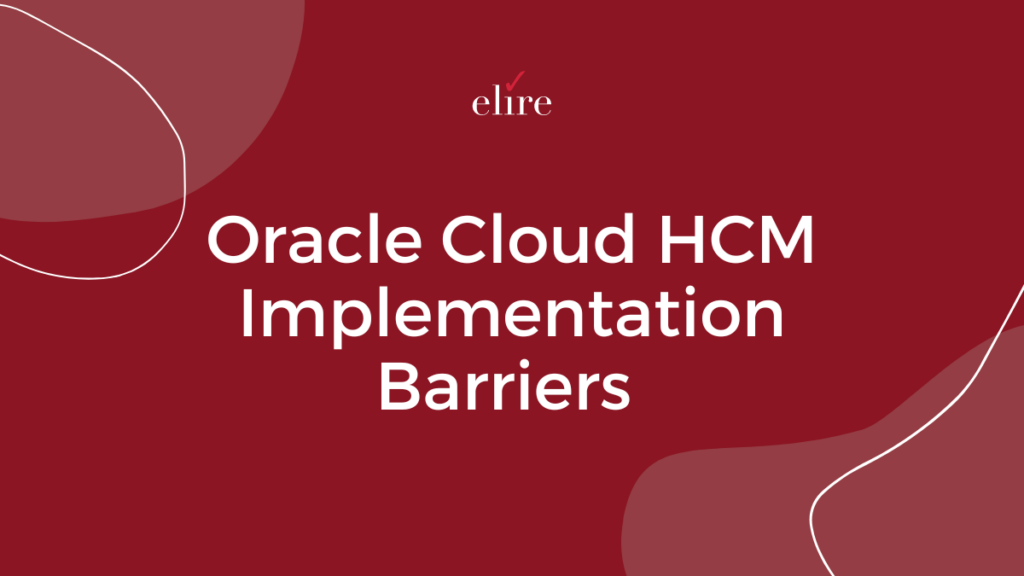
Tips to Overcome Implementation Obstacles
Embarking on an Oracle Cloud HCM implementation presents a range of challenges that can significantly impact its success. Understanding these barriers and addressing them effectively is crucial for a smooth and successful transition. This blog explores common pitfalls and offers actionable tips to overcome them.
HCM Cloud Implementation Dream Team
A successful HCM Cloud implementation begins with assembling a well-rounded team that blends technical and functional expertise. This team should start with a well-defined plan that sets clear objectives, delegates roles and responsibilities, and establishes realistic timelines. This plan should also address potential risks and include strategies for their mitigation.
Incorporating a human-centered design approach is vital. Designing the system with the end-user in mind ensures that it is intuitive and meets user needs, which is essential for driving higher adoption rates. User adoption is key to the system’s effectiveness, and engaging users early, providing comprehensive training, and addressing their concerns can significantly enhance the success of the implementation.
Additionally, effective change management requires courage. Organizations must be willing to move away from outdated processes and embrace new methods introduced by the HCM system. This involves not just technological changes, but also cultural shifts within the organization so that employees see and know the value of introducing new software and processes. Introducing change champions can be an effective means of communicating and promoting internal changes, ensuring end-users understand and accept new processes and products.
Common Cloud HCM Implementation Mistakes
Despite best efforts, organizations often fall into common traps during HCM Cloud implementations. One major pitfall is the pursuit of a perfect solution. Clients frequently seek a one-size-fits-all system that promises to resolve all their issues. However, this quest for perfection can lead to unrealistic expectations and project delays. It is crucial to acknowledge that no solution will be flawless, and that flexibility and adaptability are essential.
Another common mistake is excessive accommodation of existing processes, including those that are inefficient. This can lead to scope creep and customization overload, resulting in training delays, increased costs, and confusion. Continuous customization to fit every use case can create a never-ending cycle of adjustments and reconfigurations, diverting resources from core functionalities and undermining process improvements.
Warning Signs that an HCM Implementation is Heading for Trouble
Recognizing warning signs early can help prevent a troubled implementation. Scope creep, or uncontrolled changes to the project scope, can derail progress if not managed carefully. A lack of user involvement and insufficient training can lead to resistance and reduce the effectiveness of the new system. Unrealistic timelines that fail to reflect the complexity of the implementation can result in rushed work and incomplete solutions.
Poor change management strategies can cause confusion and resistance, impacting the project’s success. Engaging resistant stakeholders early and addressing their concerns is crucial for gaining their support. Additionally, non-existent feedback loops can lead to unresolved issues and larger problems down the line. Continuous feedback and iterative adjustments are essential for staying on track.
Tips for a Successful Cloud HCM Implementation
To navigate these barriers effectively, consider the following strategies:
- Deliver a Strong Foundational System: Focus on establishing a solid core system before diving into customizations. A robust foundation ensures that core functionalities are reliable and effective
- Understand Business Needs: Tailor the HCM system to address specific business needs. This involves mapping out existing processes, identifying areas for improvement, and configuring the system to enhance these processes
- Engage Key Stakeholders: Involve all relevant functional teams, particularly Payroll, from the beginning. Payroll interacts with nearly every module, so its early involvement ensures a cohesive system
- Prioritize User Training: Invest in comprehensive training programs that not only teach users how to operate the system but also explain the benefits and changes it introduces
- Address Resistance to Change: Resistance is natural but can be managed through consistent communication and support. Creating a supportive environment helps users transition smoothly
Implementing these strategies will set a strong foundation for success, but it’s also crucial to be aware of potential warning signs that indicate your HCM implementation might be facing challenges. By identifying these issues early, you can take proactive measures to address them and steer your project back on course.
What’s Next
Looking ahead, focus on embracing adaptive processes, maintaining consistent functional team involvement, and implementing robust change management strategies. Be prepared to adjust plans based on feedback and evolving requirements. Continuous engagement with functional teams is crucial for ensuring the system meets their needs. A strong change management strategy, including effective communication, training, and support, will help overcome resistance and facilitate a smooth transition.
By prioritizing adaptability, addressing user needs, and implementing effective change management, organizations can successfully navigate the complexities of HCM cloud implementation. Although the journey may present challenges, thoughtful planning and a proactive approach can lead to a successful and effective HCM implementation.
To learn more about successful Cloud HCM implementation and navigating project challenges, contact [email protected] or visit Elire Cloud Services page. Looking to stay up to date on all things Cloud HCM? Subscribe to Elire’s Monthly Cloud Newsletter to get Elire’s Cloud expertise delivered right to your inbox. Follow Elire on LinkedIn and Twitter to see company impacts and industry innovations with the tap of a button.
If you’re looking to optimize your Oracle Cloud HCM application, we have you covered! Navigate to Elire’s Path to Cloud webpage and find everything you need to know about making your Cloud application work for you.
Author
-

Mrs. Selness serves as Elire’s Marketing Specialist, working to develop and optimize marketing brand assets. Jordan collaborates with the Elire Team to produce blog and social media content, strategize for social media expansion, and maintain Elire’s internal and external branding.
View all posts
